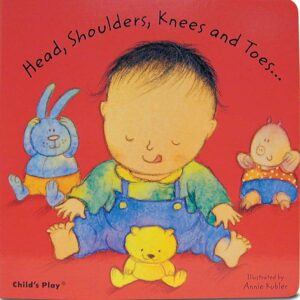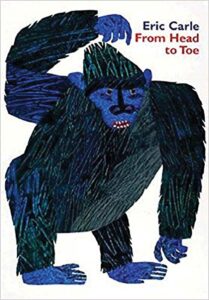Receptive language, Expressive language
Toddlers participate in a book sharing about body parts, especially head, shoulders, knees, and toes.

Head, Shoulders, Knees and Toes… by Annie Kubler


[Invite toddlers to join you to read a book. Show the book cover. Point to the boy on the book cover when you describe his actions.]
This little boy is touching his toes. All of us have toes. Where are our toes?
Let’s all touch our toes!
Our book is about parts of our body. Our head, shoulders, knees, and toes are parts of our body.
 [Engage toddlers in the book by pointing to and inviting toddlers to say the name of the body part that is the focus of each illustration. Then encourage toddlers to join you in touching the illustrated body part. Example: Pat your head with both hands and encourage toddlers to pat theirs. Describe toddlers’ actions. Example: “We are patting our heads!”]
[Engage toddlers in the book by pointing to and inviting toddlers to say the name of the body part that is the focus of each illustration. Then encourage toddlers to join you in touching the illustrated body part. Example: Pat your head with both hands and encourage toddlers to pat theirs. Describe toddlers’ actions. Example: “We are patting our heads!”]
Our book is a fun way to learn and remember the names of some parts of our body. Let’s touch our head, shoulders, knees, and toes once more!
Pay attention to the ease with which toddlers identify parts of their bodies so you can determine what pace to use in sharing the book. In general, a slower pace is appropriate for the first time the book is shared. It is likely that toddlers will differ in their familiarity with names and locations of body parts. Avoid a fast pace on the pages that review head, shoulders, knees, and toes unless you are fully confident that all toddlers in your gathering know the names and locations of these parts.
The activity description includes the benefit of inviting toddlers to say the name of the body part that is the focus of an illustration. Remember to repeat the name as you point to the part of your own body. This reinforces name recognition for some toddlers and likely introduces the name to one or more other toddlers.
Extra support
Enrichment
Receptive language, Expressive language
Toddlers participate in a book sharing about moving parts of our bodies in specific ways.



 Invite toddlers to join you in reading a book about how animals can move parts of their bodies. Use the book text and your own words to describe the animal’s actions in each illustration. Draw attention to how the illustrated person is also moving the corresponding part of his/her body (“I can do it.”). Recognize and respond to toddlers’ comments and pointing, keeping in mind that some animals probably will not be familiar to toddlers. Example: “You pointed to the donkey and said ‘horse.’ A donkey is like a horse. This donkey has bigger ears than a horse has. Let’s look at the donkey’s ears.”
Invite toddlers to join you in reading a book about how animals can move parts of their bodies. Use the book text and your own words to describe the animal’s actions in each illustration. Draw attention to how the illustrated person is also moving the corresponding part of his/her body (“I can do it.”). Recognize and respond to toddlers’ comments and pointing, keeping in mind that some animals probably will not be familiar to toddlers. Example: “You pointed to the donkey and said ‘horse.’ A donkey is like a horse. This donkey has bigger ears than a horse has. Let’s look at the donkey’s ears.”
At the conclusion of the book, invite toddlers to try doing some of the movements shown in the book’s illustrations. Provide a carpet square for each toddler. Use movements that you anticipate will be of interest to toddlers in the gathering. Show the pertinent page, read the text, and say “we can do it!” to encourage toddlers to try the movement. Lead by demonstrating and describing the movement. Examples: “The gorilla ‘thumps his chest.’ My chest is right here. I can thump my chest like this. Let’s all thump our chests like a gorilla!” “The seal can clap his hands. Where are our hands? Let’s clap our hands like the seal!”
Offering the session in two segments gives toddlers time to look closely at the bold illustrations of different animals, some of which may be unfamiliar, before trying some of the movements. Watch toddlers’ reactions to the animals and movements to determine which ones to try in the second segment. Avoid movements you anticipate will be too challenging or may generate too much excitement. Anticipate and positively acknowledge a wide range of toddler attempts at the movements.
Showing and describing a pictured movement prior to trying the movement adds extra steps in your facilitation of movements, but it is cognitively helpful for toddlers to connect an illustration of the movement to their attempts to move in a similar way. Spacing the carpet squares so toddlers can engage in physical movements is important.
Extra support
Enrichment
Materials Needed: Head, Shoulders, Knees and Toes… by Annie Kubler; From Head to Toe by Eric Carle; baby doll; teddy bear
Place the books on a low table with several dolls and teddy bears. Encourage toddlers to find body parts on the dolls/bears that correspond to illustrations in the Head, Shoulders, Knees and Toes… book, and to gently move parts of the dolls/bears in ways shown in the From Head to Toe book. Also invite toddlers to point to and/or move the pertinent part on their own bodies. Encourage toddlers to say the body part and the movement. You may wish to provide a nonbreakable mirror for toddlers to use in pointing to and moving their own bodies.
Materials Needed: Head, Shoulders, Knees and Toes… by Annie Kubler
Preschool-age children may enjoy touching their head, shoulders, knees, and toes in a slower and then faster pace. Older children may enjoy playing a simple version of “Simon Says” with body parts, such as “Simon says touch our heads.” Help older children take turns being Simon. Infants may enjoy holding a baby doll while watching their peers participate in Options 1 or 2, or the activities suggested here.